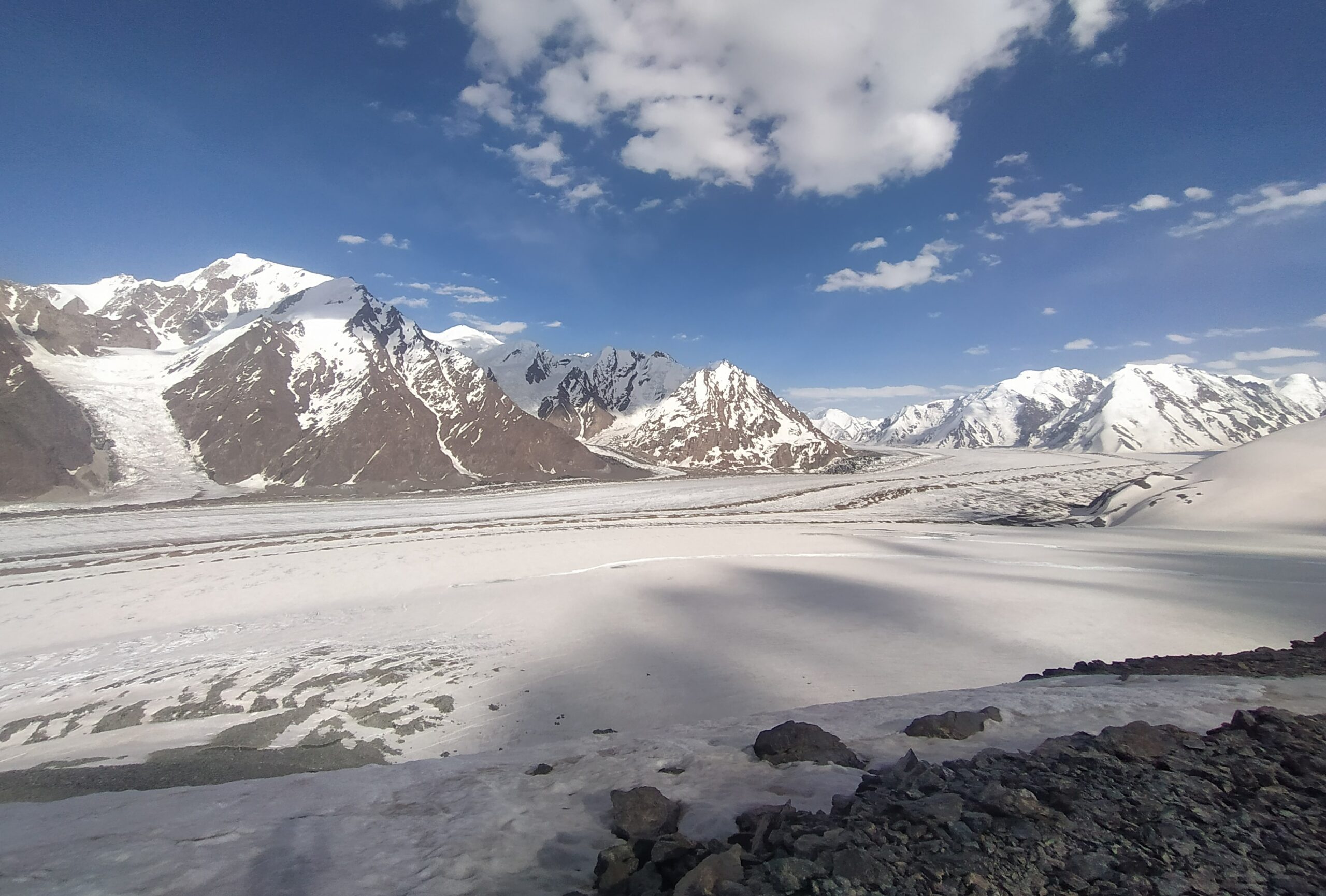The Pamir Mountains are located in a region that influences hemispheric-scale climate and is expected to experience major environmental changes as a consequence of warming, land use and water demand. Yet, central Asia’s climate is one of the least constrained globally, because of an extreme scarcity of present and past climate data and the complexity of atmospheric circulation patterns.
Ice cores from high-mountain glaciers can provide unique archives of detailed past climatic and environmental conditions. In a region such as the Pamir, where instrumental data, historical documents and other paleoclimate records are scarce, this represents a key resource to understand past and present climate.
The Climate and Environmental History Research Cluster of the PAMIR programme aims to collect an ice core from the accumulation area of Fedchenko Glacier. Fedchenko Glacier is one of the largest glacier systems in High Mountain Asia and its potential as a climate archive was recognized early on. Previous studies on a first shallow core have shown that this site has enormous potential for obtaining an ice core paleo record covering at least the last millennium with high temporal resolution. Since that initial study, no other attempts to collect a deep ice core have been successful, due to very difficult access and extremely challenging logistics.
Coring Fedchenko Glacier is an urgent task, since the glacier has retreated and thinned in recent times, and this thinning is expected to accelerate in the coming decades, wiping away the accumulation zones of the glacier and with them a unique archive of climate and environmental data.
If successful, the ice core will allow reconstructing past changes in snow accumulation, precipitation origin, and regional scale atmospheric dynamics. It will provide novel data evidence to test the competing hypotheses that have been put forward to explain the unique state of the cryosphere in the region: increased precipitation at high elevations due to enhanced Westerlies, summertime cooling, or an increase in summertime precipitation due to irrigation in the agricultural regions adjacent to the Pamir. It will provide a novel archive documenting air pollution and early human impact, e.g. from mining activities. In case the ice is frozen to the bedrock, the age of that ice, obtained by micro-radiocarbon dating, will allow to establish whether Fedchenko is a remnant of the last glaciation or originated during the Holocene as suggested for glaciers in the Tibetan Plateau (Hou et al. 2018).
Our research will be complemented with cosmogenic exposure datings of boulders exposed after glacier retreat in a number of glacial valleys transecting the Pamir Mountains from West to East. With such cosmogenic exposure dating of boulders, we aim to improve the knowledge of paleo-glaciological history during the last 10’000 years.
Glaciers are now recognized as a distinct biome with its particular microbial life. We will therefore use parts of the Fedchenko ice core to study the ice-locked microbial life. The use of cell counts, 16S rRNA amplicon sequencing and metagenomics of sample layers throughout the core will shed light on the responses of microorganisms to climatic variations and air pollution, and will greatly expand our understanding on the evolutionary history and adaptive traits of bacteria within the icy archive.
Glaciers are also major repositories of dissolved organic matter (DOM) (Singer et al. 2012, Hood et al. 2015). Therefore, we will use ultrahigh-resolution mass spectrometry on ice aliquots to characterise the molecular composition of the DOM. This will provide novel knowledge on the sources (e.g., microbial versus dust) and diagenesis of the icelocked DOM.
Cluster Participants
Margit Schwikowski, Professor, PSI and UniBe. High-altitude ice core research, Cluster PI.
Theo Jenk, Senior scientist, PSI. Drilling expedition leader and ice core dating.
Anja Eichler, Senior scientist, PSI. Analysis of trace elements and stable isotopes.
Evan S. Miles, Postdoc, WSL. Ice thickness and accumulation surveys.
Francesca Pellicciotti, Senior Researcher, WSL. Glacier behaviour and accumulation.
Martin Hoelzle, Professor, UniFr. Borehole temperatures.
Tomas Saks, Senior scientist, UniFr. Expert in glaciology in Central Asia, will advise the core team.
Tom J. Battin, Professor, EPFL. Reconstructing microbial life in the ice and DOM biogeochemistry.
Christoph Raible, Professor, UniBe. Climate system modelling.
Francoise Burgay, Postdoc, PSI.
Local Partners
Abdulhamid Kayumov, Professor-Director, CGR (Tajikistan). Pamir glacier expert, logistics, permitting, interface with local stakeholders.
International Partners
Christoph Mayer, Senior scientist, BADW, Germany. Glaciological survey for drilling site selection.
Astrid Lambrecht, Senior scientist, BADW, Germany. Glaciological survey for drilling site selection.
Fanny Brun, Senior scientist, IRD, France. Glaciological survey for drilling site selection.
Robert Spencer, Professor, FSU, USA. Ultrahigh-resolution analyses of ice-locked DOM.
Flory Kern, Mountain Guide, Director of Ski Berge Abenteuer GmbH, Germany. Coordination of helicopter logistics.
Ivan Lavrentiev, Senior Scientist, Russian Academy of Sciences.
